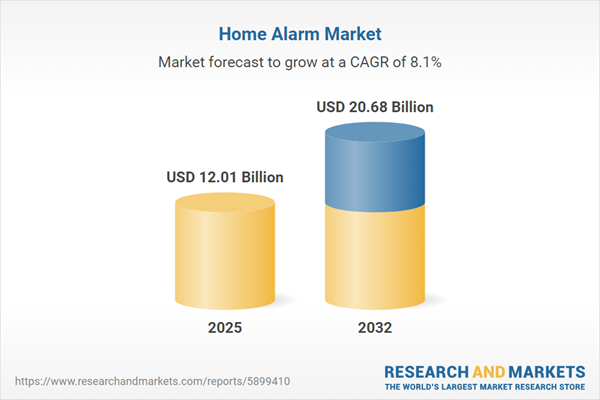Speak directly to the analyst to clarify any post sales queries you may have.
The home alarm market is evolving quickly, driven by increasing demand for intelligent, connected security solutions and rising expectations for seamless user experiences. Senior decision-makers are facing a market environment shaped by shifting consumer priorities, regulatory complexity, and continuous technology innovation.
Market Snapshot: Home Alarm Market Size and Growth
The Home Alarm Market grew from USD 11.11 billion in 2024 to USD 12.01 billion in 2025. It is expected to continue growing at a CAGR of 8.06%, reaching USD 20.68 billion by 2032.
Scope & Segmentation of the Home Alarm Market
This comprehensive report analyzes the home alarm market, delineating the industry landscape across product categories, technology use, distribution channels, and regional markets:
- Product Types: Access control devices, cameras (indoor and outdoor), control panels, multiple sensor varieties (door/window, glass break, motion, smoke/CO), sirens, and alarms.
- Monitoring Types: Professional monitoring and self-monitoring services.
- Installation Types: DIY and professional installations.
- System Types: Wired and wireless solutions with varying scalability for residential and commercial users.
- Distribution Channels: Direct sales, online retail (company websites and e-commerce platforms), specialty stores, and telecom operators leveraging bundled offerings.
- End Users: Commercial enterprises and residential homeowners with distinct security and compliance priorities.
- Regions: Americas (North America, Latin America), Europe, Middle East & Africa, and Asia-Pacific. Notable sub-regions include the United States, Canada, Brazil, United Kingdom, Germany, France, China, India, Japan, and others.
- Technologies: Integration of AI-powered analytics, cloud platforms, smart home connectivity, wireless protocols, and advanced video analytics.
Key Takeaways for Strategic Decision-Makers
- Smart home platforms and advanced analytics are now central to market competitiveness, driving integration of alarms with user-friendly mobile and connected systems.
- Heightened attention to cybersecurity and privacy is influencing vendor differentiation, with end-to-end encryption and secure data management becoming essential features.
- Modular system architectures enable flexible adaptation to evolving security needs and regulatory requirements for both new and retrofit installations.
- DIY models and affordable wireless technologies are widening market access and transforming the value proposition for both consumers and smaller commercial upgrades.
- Providers are increasingly leveraging partnerships with telecoms and electronics suppliers to streamline supply chains and bundle alarm services with connectivity.
- Business models are shifting toward ongoing service and subscription revenue, as customer loyalty depends on tiered options and intuitive experiences.
Tariff Impact on Supply Chain and Cost Structure
Revised import tariffs in 2025 significantly altered the home alarm sector’s cost landscape, primarily impacting components such as cameras, sensors, and control panels. These measures pushed manufacturers to reevaluate sourcing strategies, spurring greater investment in regional manufacturing and supplier diversification. Stakeholders are emphasizing local partnerships and resilient procurement models to manage price containment and market agility. End users may experience service plan adjustments, driven by elasticity in demand and hardware cost fluctuations. This environment emphasizes lean inventory management and alternative wireless architectures to minimize reliance on high-tariff imports.
Methodology & Data Sources
This analysis uses structured primary research, including interviews with industry leaders, security professionals, and regulatory specialists. Secondary research comprises regulatory filings, technical literature, and market publications. Cross-verification and data triangulation underpin the findings, supported by trend analysis and scenario-based evaluations.
Why This Report Matters
- Informs strategic planning by synthesizing qualitative and quantitative market insights for effective opportunity mapping.
- Enables risk mitigation through up-to-date understanding of compliance frameworks, supply chain pressures, and tariff implications.
- Supports resource allocation and go-to-market decisions by highlighting preferred business models, partnership opportunities, and relevant technologies.
Conclusion
The home alarm market is shaped by shifting customer expectations, regulatory changes, and rapid technology evolution. This report enables decision-makers to navigate complexity, uncover new opportunities, and drive resilient, customer-focused growth strategies.
Additional Product Information:
- Purchase of this report includes 1 year online access with quarterly updates.
- This report can be updated on request. Please contact our Customer Experience team using the Ask a Question widget on our website.
Table of Contents
3. Executive Summary
4. Market Overview
7. Cumulative Impact of Artificial Intelligence 2025
Companies Mentioned
The companies profiled in this Home Alarm market report include:- ADT Inc.
- Securitas Direct AB
- Prosegur Compañía de Seguridad, S.A.
- Vivint Smart Home, Inc.
- Comcast Corporation
- Ring LLC
- SimpliSafe, Inc.
- Brinks Home Security, LLC
- Resideo Technologies, Inc.
- Alarm.com Holdings, Inc.
Table Information
| Report Attribute | Details |
|---|---|
| No. of Pages | 198 |
| Published | November 2025 |
| Forecast Period | 2025 - 2032 |
| Estimated Market Value ( USD | $ 12.01 Billion |
| Forecasted Market Value ( USD | $ 20.68 Billion |
| Compound Annual Growth Rate | 8.0% |
| Regions Covered | Global |
| No. of Companies Mentioned | 11 |









